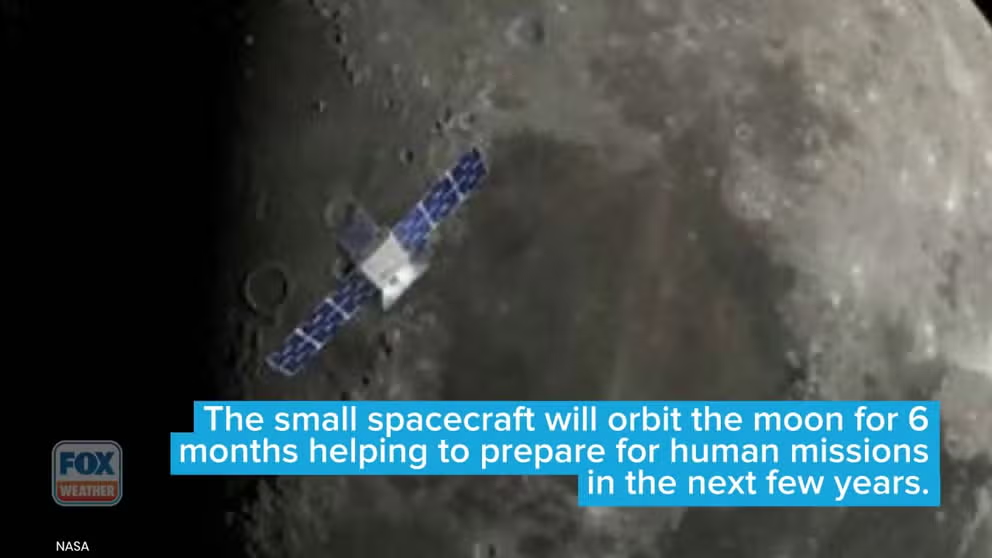NASA spacecraft remains on track for moon arrival after brief communications blackout
Communication outage caused by a series of issues converging, according to spacecraft operator Advanced Space

Artist rendering of CAPSTONE flying in cislunar space – the orbital space near and around the Moon. The mission will demonstrate an innovative spacecraft-to-spacecraft navigation solution at the Moon from a near rectilinear halo orbit slated for Artemis’ Gateway. (Credits: Illustration by NASA/Daniel Rutter)
(NASA)
Operations are back to normal for NASA's CAPSTONE spacecraft on the way to the moon after a communication outage early during the mission caused engineers to rapidly work to get the spacecraft phoning home again.
On Thursday, CAPSTONE conducted its first trajectory correction maneuver, ensuring it's on the right track toward the moon. The maneuver was delayed a day after the satellite stopped communicating via NASA's Deep Space Network (DSN) for about 24 hours.
HOW TO WATCH FOX WEATHER ON TV
CAPSTONE stands for Cislunar Autonomous Positioning System Technology Operations and Navigation Experiment. It is a technology demonstration mission designed to test navigating around the moon in a Near-Rectilinear Halo Orbit before NASA uses this same specialized orbit for the Lunar Gateway, where astronauts will stop before heading down to the moon in 2025. CAPSTONE is managed and operated for NASA by Colorado-based Advanced Space.
NASA's CAPSTONE mission will test out Gateway orbit
Launching in 2022, the microwave-size spacecraft will orbit the moon to test out NASA's Lunar Gateway orbit before humans arrive in 2025.
The NASA mission kicked off on June 28 when CAPSTONE launched from New Zealand and, on July 4, separated from Rocket Lab's Lunar Photon upper stage, leaving Earth's orbit and setting it on the path to lunar transfer orbit.
However, 11 hours after separation, the satellite was not communicating via the DSN, which consists of a series of antennas worldwide NASA uses to download and upload data to spacecraft all over the universe.
JULY'S FULL BUCK MOON WILL BE BRIGHTEST SUPERMOON OF THE YEAR
According to NASA, the brief blackout with the spacecraft started when the DSN team noticed inconsistent ranging data. In response, the spacecraft operations team attempted to access diagnostic data on the spacecraft's radio and "sent an improperly formatted command," making the radio inoperable. Usually, the spacecraft should have rebooted the radio but did not because of the problem in the flight software, according to NASA. Eventually, the spacecraft's flight software cleared the faulty command and brought the spacecraft back into communication with the DSN.
Advanced Space said mission operators re-established a signal at 7:26 a.m. MT Wednesday. After confirming the spacecraft was in good health, teams executed the first trajectory correction maneuver Thursday morning, which was successful.
Anomalies like the communication outage are rarely caused by a "single issue but instead are the result of a series of issues that converge in an unexpected way," Advanced Space said.
"For CAPSTONE, this series of events began during commissioning with an improperly formatted command that triggered a radio vulnerability and was compounded by a spacecraft flight software contingency response fault," Advanced Space said. "The system was ultimately recovered by the team as a result of autonomous flight software system operations that cleared the fault and brought the system back into communication with the ground."
CLICK HERE TO GET THE FOX WEATHER UPDATE PODCAST
However, even during the communication outage, CAPSTONE continued to function in space autonomously as designed, maintaining its positioning and battery charge.
Regardless of the early mission hiccup, CAPSTONE is still scheduled to arrive in lunar orbit on Nov. 13. Another small trajectory correction maneuver is planned for Saturday.
